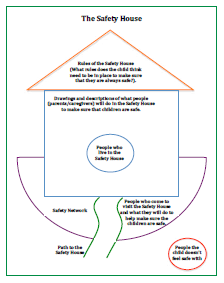Practitioners can use several tools to bring the young person into the decision-making process and help them to actively participate in matters that directly affect their lives. These will help to ensure the engagement with the young person is meaningful and age-appropriate and will elicit the information needed.
These tools can help you to implement the vision of the Strengthening families Protecting children Framework for Practice—that Queensland children and young people are cared for, protected, safe and able to reach their full potential.
The Immediate Story
The Immediate Story is a clear, simply worded story that is developed by the practitioner and the young person at the point when the young person is removed from the parents’ care to a care arrangement.
The Immediate Story provides a simple explanation to the young person about the reason for the child protection intervention, about what is happening now or has just happened (for example, the young person going to stay with other family members or with foster carers), and what is going to happen next in the collaborative planning process.
This tool helps reduce the impact of trauma and shares information in a simple yet meaningful way so young people understand as much as possible what is happening when commencing a care arrangement.
The Three Houses Tool
The Three Houses Tool is intended to help bring the voice of children, young people, carers and family members more fully into information gathering processes, assessments, and plans.
It contains a simple graphic of three houses, which are used to help individuals and families externalise and explore what is happening in their lives, particularly in relation to danger and harm, safety factors, and their hopes and dreams. The tool involves both drawing and words and is an effective tool to help young people express their worries, what makes them happy and what they would like from their care arrangement.

The Future House
The Future House tool can assist practitioners in finding out what young people think needs to be happening in their life for them to be safe and well in the future, in relation to the identified worries.
Eliciting the young person’s goals is a necessary first step in working with them and their carer to develop a joint vision of what future safety, belonging and wellbeing will look like, and of the specific day-to-day behaviours and actions that can achieve this.
This tool is beneficial for future planning with a young person who is transitioning to adulthood and is actively thinking about their future. The tool is also great to use with young people who may not know what their future holds and need some help exploring this to help ease any overwhelming and anxious feelings transitioning to adulthood can bring about.

Published on:
Last reviewed:
-
Date:
Maintenance
-
Date:
Maintenance
-
Date:
Terminology change - placement to care arrangement
-
Date:
Terminology change - placement to care arrangement
-
Date:
Maintenance.
-
Date:
Page created


